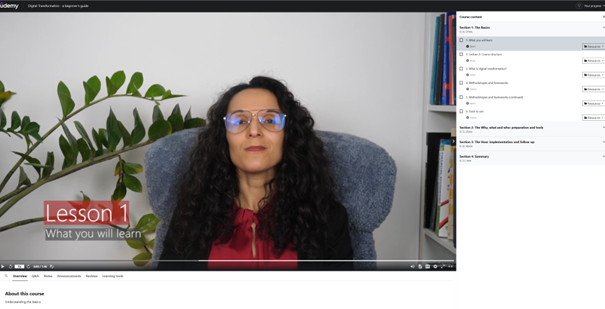I have been wanting to create my own course on the subject of Digital Transformation for a while – as away of formalizing my competencies in the field, and as a way to challenge myself in the domain of filming and video editing.
To start off, I should mention I knew nothing about the subject area of film and video editing, and had set up a film making bonanza day with a friend back in 2020 to learn more. Despite having spent roughly 3 000 euros on material I paused the whole project, finding it too time consuming and difficult. As I have mentioned in previous blog posts I am quite into self-improvement and for 2022 one of my goals was to finish the course on Digital Transformation.
This post will be a summary of my journey of creating an online course and publishing it in a matter of days. Well, in total – I have thought about the course for a considerably longer time then it took to execute it.
Step 1 – Getting the proper gear
What kind of gear you should get depends on your budget, the kind of result you wish to get and your level of nerdiness.
I had the means, wanted good results and am a nerdy – but not enough of a video/film nerd to spend too much time researching cameras and microphones days on end.
I asked my friend who loves video cameras for some tips, researched a few articles on video and audio quality and attended a “make your own digital course” webinar set up by Evan Kimbrell.
I settled for the following gear:
- Camera for filming: Panasonic Lumix DC-GH5 kamerahus + Leica DG Vario-Elmarit 12-60/2,8-4 ASPH (ca 1 800 EUR)
- Video card for the camera: Sandisk Minneskort SDXC Extreme Pro 64GB 170MB/s UHS-I V30 U3 C10 (ca 30 EUR)
- Video tripod: Benro Videostativkit KH25N (ca 170 EUR)
- Microphone: Røde Mikrofon VideoMic NTG (Ca 290 EUR)
- Microphone stand: Hamilton KB229M
- Light: two Godox LED Belysning SL60W Dagsljus 230V (ca 190 EUR each)
- Prompter: Leeventi (ca 90 EUR)
- Editing software: Adobe Premiere Pro – I chose a larger package including other Adobe solutions, and pay roughly 50 EUR a month
I also had to invest on a better computer, as my poor Dual core laptop from way back when of 2015 – the Adobe Premiere Pro requires a bit more of a computer than what the laptop could muster. I needed the new computer for coding and other business work anyways, so it was a good investment, and it was about time I got that hardware update.
Step 2 – Finding the correct platform for your course
It was not obvious for me to focus on Udemy as the platform of choice – I looked at coding a new WordPress page dedicated to the course or paying for a ready-made course page via external sources. I chose Udemy (despite the big cut they take off your royalty) as it was the smoothest and easiest choice and makes marketing your course easier.
The whole process is basically drag and drop based, where you upload your videos and resource material, and set up any quiz you need to add to the course. The whole set-up took a quarter of an hour, tops.
Step 3 – Filming and editing
Ah, filming. I tried to film after work hours a few times. Took to long to set up stuff, wasn’t in the right mood and never satisfied with the output video or audio quality wise. I am not kidding, I had the camera gear set up weeks on end at times without touching them, and filmed a total of two times in 2021.
When my vacation in May 2022 started, I decided to be finished with the course and said to myself to dedicate a week full time for the project.
I watched a few videos on the subject of editing and adding some basic effect. I filmed and edited for three days straight and took a half day for quiz and resources.
I am sure that if I had put more time and filmed more the quality might have been better, but a I have learned the hard way that perfection is quite impossible to achieve and I am quite good at comparing effort put into things versus the value you gain from the added effort.
For your project, you will need to find your own balance. I believe a rough estimate would be to spend ca 30 hours on a course of two hours as a minimum.
My course became 2 hours in length, which was my aim.
Step 4 – Publishing and marketing
As I started off with, actually uploading the finished material into Udemy took no time at all – the most time consuming bit was getting approved by their third-party payment service provider Payoneer (which is understandable, they need to double check your details to make sure you are not a terrorist and/or laundering money).
I put up posts on my social media pages, and on my brand page amiraroula.com. I will also set up a press release, because why not – I did that for my InsurTech book (and should probably have done it for my novel!). There is the option of Google Ads / other digital marketing, but that is something I will refrain from for the time being.
And now the course is up in the internetz! Live on Udemy, do check the course out 😊

Comments are closed